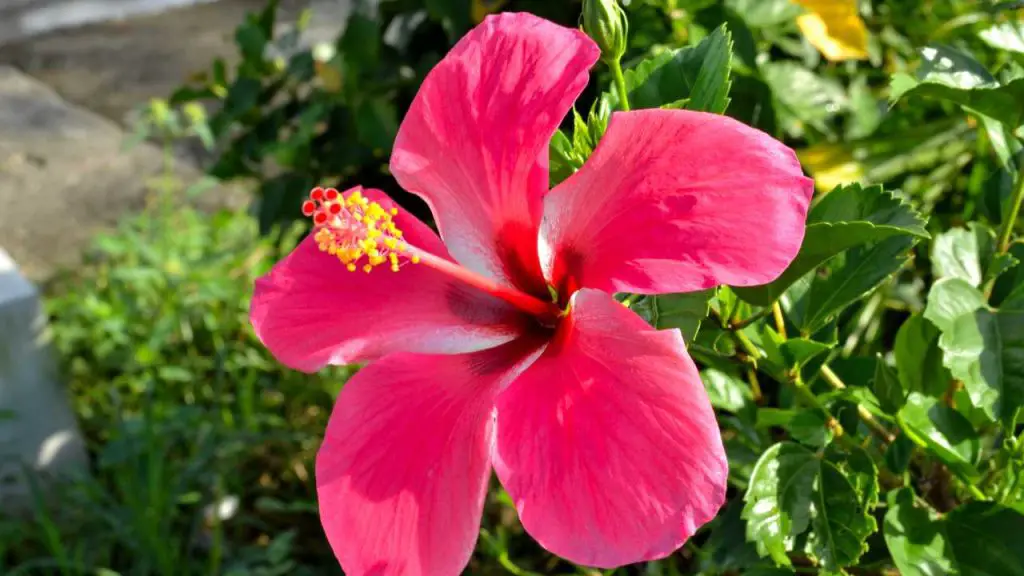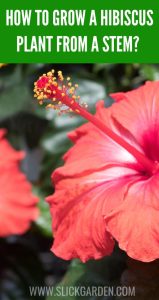Gardeners and homesteaders always look for plants that can have multiple benefits. They should fulfill the requirement and passion of gardening and add ornamental value to the space. Also, it should be used for eating or drinking.
Well, there is a great plant named hibiscus. It not only fulfills the ornamental value but also can be used for medicinal purposes. That’s why we are going to talk about how to grow a hibiscus plant from the stem.

Hibiscus plant
Belonging to the family Malvaceae, the hibiscus is a flowering plant. This plant grows well and s native to subtropical, tropical, and warm temperate regions of the Americas, Asia, and Africa.
Hibiscus plants are known for their showy and colorful flowers, which can range in size from small to very large and come in various colors such as red, pink, white, yellow, and orange. There are many species of hibiscus plants, but some of these for gardening and landscaping include the tropical hibiscus, hardy hibiscus, and the rose of Sharon.
Hibiscus plants grow well in well-drained soil that is kept moist but not waterlogged, and in full sun to partial shade. They can be grown in containers or in the ground, depending on the species and the climate. Hibiscus plants require regular watering and fertilizing to promote healthy growth and blooming.
There are many benefits of planting hibiscus. Here are some of the important benefits you can get from this plant.
Attractive appearance
Hibiscus plants are known for their beautiful and showy flowers that come in a range of colors and sizes. They can add a splash of color to any garden or landscape and make for a stunning display. These colors include orange, yellow, red, pink, and others.
Easy to grow
Hibiscus plants are generally easy to grow and require minimal maintenance. They can be grown in containers or in the ground and are suitable for both novice and experienced gardeners. That’s why it is liked by gardeners of all ages.
Wildlife habitat
Hibiscus plants can attract a variety of beneficial insects, such as bees, butterflies, and hummingbirds, which can help to pollinate other plants in the garden. They can also provide shelter and habitat for wildlife.
Medicinal properties
Hibiscus plants have been used for medicinal purposes in various cultures. The flowers and calyces of the hibiscus plant are commonly used to make teas and other beverages, which are believed to have a variety of health benefits.
Environmental benefits
Planting hibiscus can help to improve the environment by reducing erosion, improving soil quality, and providing shade and cooling during hot weather. Also, hibiscus plants are often associated with
love, beauty, and happiness in many cultures, and planting them can add symbolic meaning to your garden or landscape.
Overall, planting hibiscus can be a great way to enhance the beauty of your garden, attract wildlife, improve the environment, and enjoy its potential health benefits. Plant it and enjoy it.
How To Grow A Hibiscus Plant From A Stem?
Hibiscus can be grown from seeds as well. But you can grow hibiscus from the stem by following some easy steps. Here’s a step-by-step guide on how to grow hibiscus plants from stem cuttings:
Choose a healthy hibiscus stem
Select a healthy stem from a mature hibiscus plant that has no flowers or buds on it. Cut the stem at a 45-degree angle, using a sharp, clean pair of pruning shears. Make sure the shears are rust-free. Otherwise, it can cause problems for the plants.
Remove leaves from the stem
Remove all of the leaves from the bottom half of the stem, leaving only a few leaves at the top. Especially from the base remove all of the leaves. The leaves on the upper part are ok.
Dip stem in rooting hormone
You must get hormone powder or liquid and dip the stem in it. This helps the stem to develop roots more quickly. You can use any rooting hormone solution. These are easily available in the market.
Plant hibiscus stem in the soil
Fill a small pot or container with a well-draining potting mix, and make a small hole in the center. Insert the stem cutting into the hole, and gently press the soil around the stem to hold it in place. If you are planting more than one keep an adequate distance.
Water the stems
Water the soil thoroughly, but be careful not to overwater. Keep the soil moist but not waterlogged. It can cause root rot. Provide humidity. Cover the pot with a clear plastic bag or plastic wrap to create a mini greenhouse, which will help maintain the humidity level. Keep the pot in a warm and bright location, but out of direct sunlight.
Wait for roots to grow
After a few weeks, new growth should appear on the stem, indicating that the roots have started to grow. Once the plant has established roots, you can remove the plastic cover and gradually expose the plant to more light.
Transplanting the rooted stems
When the plant has outgrown its container, transplant it to a larger pot or in a garden bed with fertile soil, and provide it with regular care, including watering, fertilizing, and pruning. Make sure you have selected good soil.
Hibiscus can grow well in slightly acidic or neutral PH soil. make sure it is not basic soil. add compost to make the soil nutrient rich. Also, it is important that you plant it with care so that the roots are not damaged.
Plant the hibiscus in a sunny place. Because it likes sun exposure to grow well. In the shades, it might grow well but will not flower. With these simple steps, you should be able to successfully grow a new hibiscus plant from the stem cuttings.
Keep Reading
- Best Annuals Flowers For Raised Beds
- What Flowers To Plant In The Fall And Winter?
- Flowering Plants For Very Small Pots
- 20 Shade-Loving Flowering Plants

Taking Care Of Hibiscus Plants
Hibiscus plants are beautiful and vibrant flowering plants that require a little bit of care to thrive. Here are some tips to help you take care of your hibiscus plants:
Watering schedule
Hibiscus plants need to be watered regularly but not over-watered. It’s best to water them deeply once or twice a week, depending on the weather and the soil moisture. Make sure the soil is well-drained, and don’t let it dry out completely between watering.
Sunlight requirements
Hibiscus plants need plenty of sunlight to grow and flower. They prefer at least six hours of direct sunlight per day, so make sure to place them in a sunny spot. The long process of photosynthesis is required for this plant.
Fertilizer requirement
Hibiscus plants benefit from regular fertilization to promote healthy growth and abundant blooms. Use a balanced fertilizer, such as a 10-10-10 formula, once a month during the growing season. Don’t over-fertilize. It might damage the hibiscus plant.
Pruning the hibiscus
Prune your hibiscus plants regularly to promote bushy growth and remove any dead or diseased branches. You can also prune your hibiscus plant to shape it and encourage more blooms. Pruning also helps the plant to develop immunity against diseases.
Pests and Diseases
Hibiscus plants are susceptible to pests and diseases, such as aphids, whiteflies, spider mites, and fungal infections. Keep an eye out for any signs of pests or diseases, and treat them promptly with organic or chemical controls if necessary.
You can consult with a nearby horticulturist if you see any unusual symptoms. It is because there are diseases and pests that can be climate or area specific.
Harvesting And Storing
As hibiscus has many medicinal uses. It is harvested and stored. Both the flowers and leaves are harvested and stored. Here are steps to harvest and store hibiscus:
Harvesting
The best time to harvest hibiscus flowers is in the morning when they are fully open. Use sharp scissors or garden shears to cut the flowers just below the base of the flower bud. Avoid cutting the stem too short, as this can damage the plant and reduce future flower production.
Cleaning
Once you have harvested the flowers, remove any leaves or debris that may be attached to them. Rinse the flowers gently in cool water to remove any dirt or insects.
Drying
There are several methods you can use to dry hibiscus flowers. One method is to lay the flowers out in a single layer on a clean, dry surface, such as a paper towel or a mesh drying rack.
Allow the flowers to dry in a warm, dry place, out of direct sunlight, for several days until they are completely dry and brittle.
Alternatively, you can tie the flowers together in small bunches and hang them upside down in a cool, dry, dark place for several days.
Storing
Once the flowers are completely dry use a container that is airtight. Keep the container in a cool, dark place to help preserve the color and flavor of the flowers.
In short, the hibiscus plant can be easily grown from stems. And with proper care, you can get a good ornamental plant with medicinal usage in the garden.
